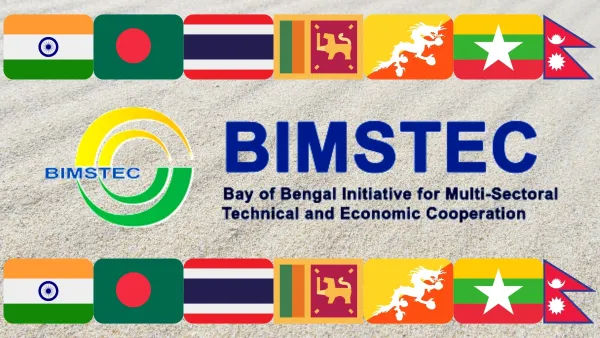Table of contents
Introduction
The Bay of Bengal Initiative for Multi-Sectoral Technical and Economic Cooperation (BIMSTEC) is a multilateral regional organization established with the aim of accelerating shared growth and cooperation among littoral and adjacent countries in the Bay of Bengal region.
- It comprises seven member countries: five from South Asia (Bangladesh, Bhutan, India, Nepal, and Sri Lanka) and two from Southeast Asia (Myanmar and Thailand).

Historical Background
- BIMSTEC was founded as BIST-EC (Bangladesh, India, Sri Lanka, and Thailand Economic Cooperation) in June 1997 with the adoption of the Bangkok Declaration.
- Myanmar joined later in 1997, leading to the renaming of the organization to BIMST-EC.
- In 2004, the organization adopted its current name, BIMSTEC, when Nepal and Bhutan became members.
Evolution of Regional Integration
The Bay of Bengal region was one of the world's most integrated regions until the early twentieth century. However, after the 1940s, as countries in the region gained independence and pursued separate goals and alliances, the sense of regional community eroded.
The establishment of BIMSTEC aimed to revive connectivity and common interests among the member countries of the Bay of Bengal region.
BIMSTEC’s first Secretary General, Sumith Nakandala, emphasized this by stating that the organization was about "rediscovering the common heritage around the Bay of Bengal."

Organizational Structure
BIMSTEC is distinct from other regional groupings such as SAARC or ASEAN due to its sector-driven approach.
- This means that goals and areas of cooperation are divided among the member states.
- Initially, India was responsible for sectors like transportation, tourism, and counter-terrorism.
- In a virtual BIMSTEC Colombo summit which took place on March 30, 2022, decision was taken to reduce, re-constitute and reconstruct the number of sectors of co-operation from the unwieldy 14 to a more manageable 7.
- Trade, Investment and Development - Bangladesh
- Environment and Climate Change - Bhutan
- Security and Energy - India
- Agriculture and Food Security - Myanmar
- People-to-people Contact - Nepal
- Science, Technology and Innovation - Sri Lanka
- Connectivity - Thailand
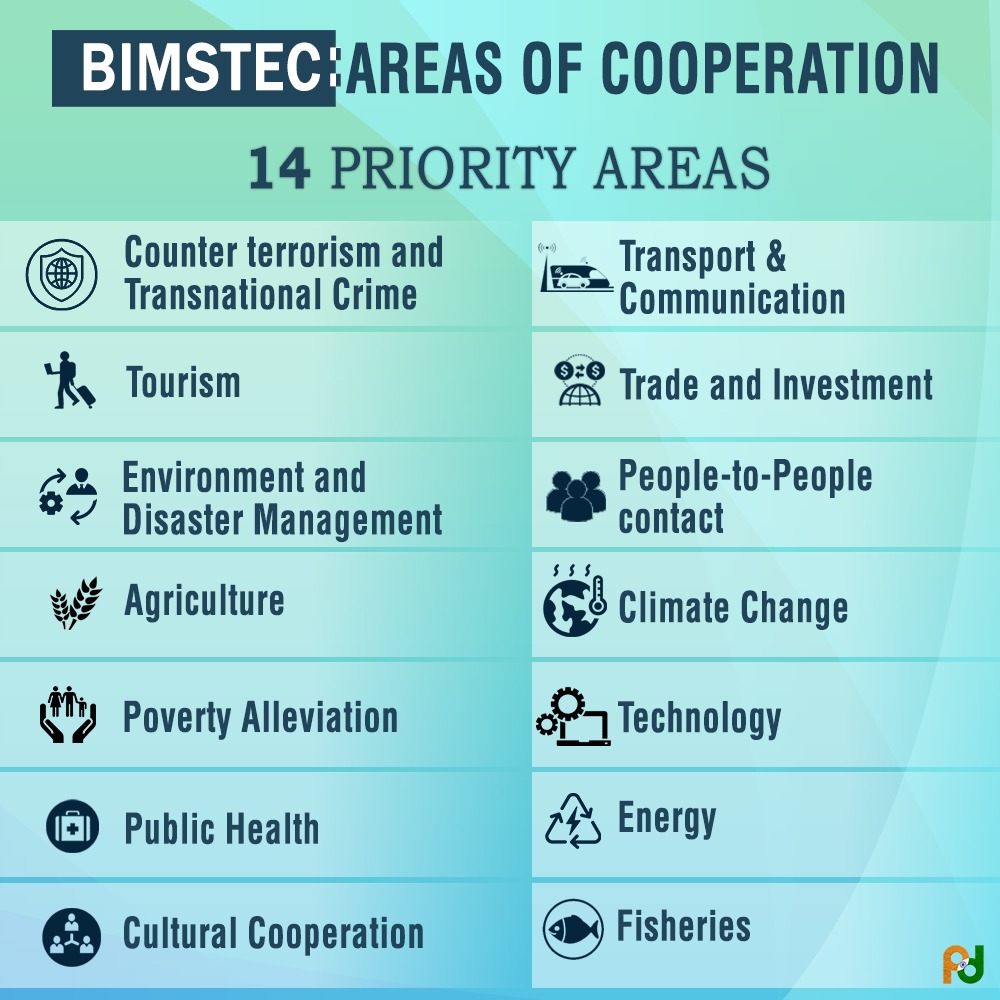
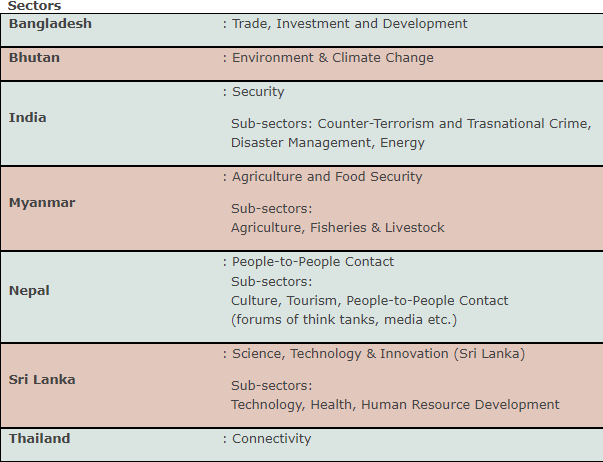
India now leads the security pillar, encompassing counter-terrorism, transnational crime, disaster management, and energy.

Working Mechanism
Before the adoption of the BIMSTEC Charter at the current summit (2024), the organization did not have a formal document or organizational architecture.
Following the pandemic, the leaders of the BIMSTEC nations met virtually on 30 March 2022 under the chairship of Sri Lanka and adopted the charter.
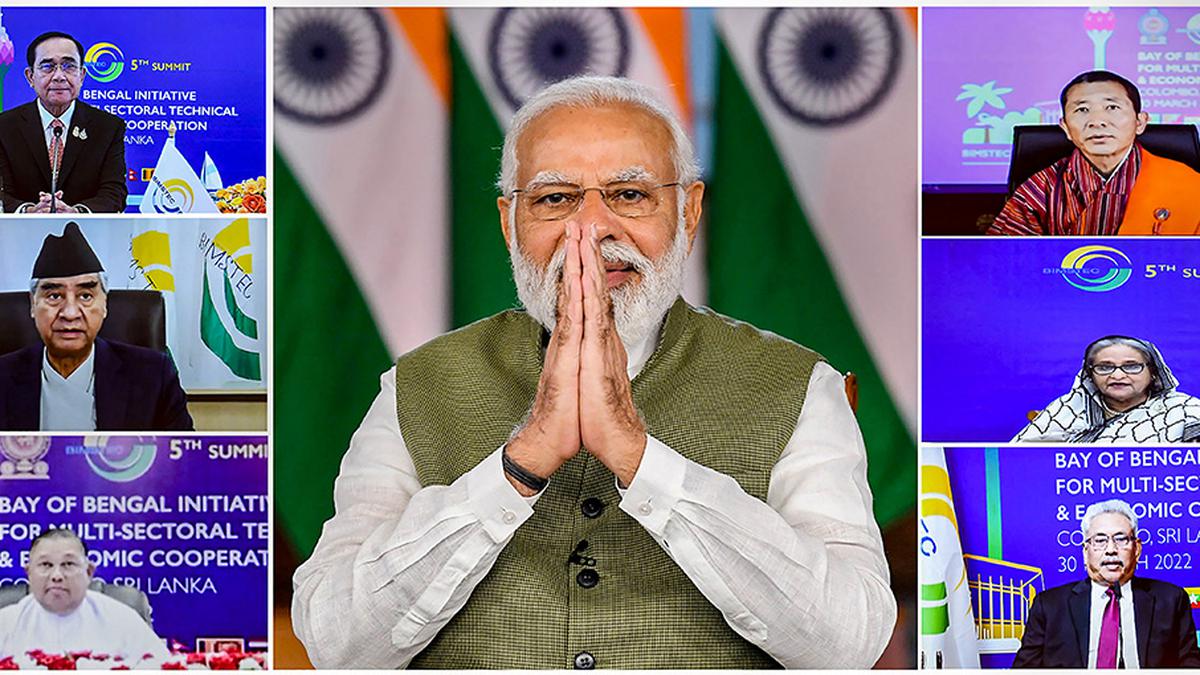
The chair of BIMSTEC was taken up by Thailand after the 5th leaders' summit.
However, it did have a working mechanism for policy-making and operational goals:
- Summits: Held every two years.
- Ministerial Meetings: Foreign and Commerce Ministers meet annually to discuss trade and economic affairs.
- Senior Officials' Meetings: Held twice a year to monitor activities.

Despite this structure, policy-making meetings have not been held regularly, with only five summits in 25 years and several ministerial and senior officials' meetings postponed or not held as planned.
BIMSTEC established its headquarters in Dhaka in 2011, and its first Secretary General was appointed in 2014.
BIMSTEC Charter
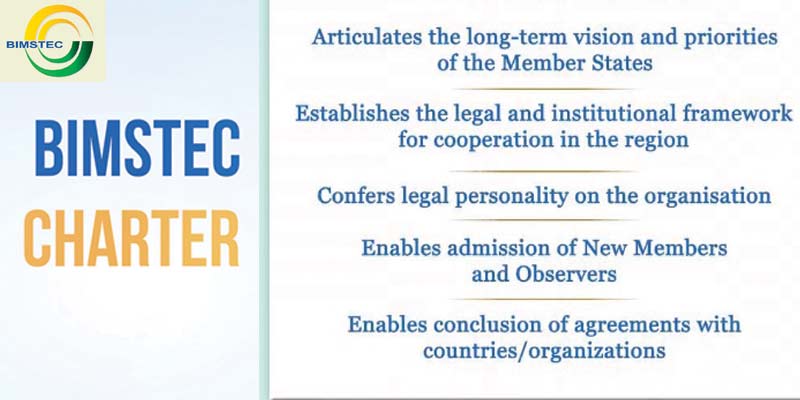
Current Chair and Coordination
The BIMSTEC uses the alphabetical order for the Chairmanship.
- The Chairmanship of the BIMSTEC has been taken in rotation commencing with
- Bangladesh (1997–1999, 2005-2006)
- India(2000, 2006-2008)
- Myanmar(2001-2002, 2009-14)
- Sri Lanka(2002-2003, 2018-2022)
- Thailand(2004-2005, 2022-now)
- Nepal(2015-2018)
The BIMSTEC Working Group holds monthly meetings at the Dhaka secretariat to review progress.
Significance of BIMSTEC

BIMSTEC represents a region with 22% of the world's population (1.68 billion people) and a combined GDP of $3.697 trillion annually.

For India, BIMSTEC aligns with its 'Act East' policy and aims to gain prominence in the Indian Ocean region and the broader Indo-Pacific region.
For other member countries:
- Bangladesh: Sees BIMSTEC as a platform for economic development.
- Sri Lanka: Aims to become a hub for shipment in the Indo-Pacific region.
- Nepal and Bhutan: The landlocked countries view BIMSTEC as their gateway to the sea.
- Myanmar and Thailand: Aim to reduce dependence on China and access a larger consumer market.
China’s increasing influence in the Indian Ocean through its Belt and Road Initiative (BRI) in all BIMSTEC countries except India and Bhutan highlights the strategic importance of BIMSTEC for India.
Also read: How did BIMSTEC acquire a "LEGAL PERSONALITY"?
Challenges and Setbacks
Despite its potential, BIMSTEC faces significant challenges:
- Efficiency: Inconsistent meetings and a sluggish pace of progress hinder its effectiveness.
- Financial and Manpower Issues: The BIMSTEC secretariat lacks adequate financial and manpower resources.
- India's Selective Interest: India's increased focus on BIMSTEC often correlates with issues within SAARC, particularly due to tensions with Pakistan.
Trade and Connectivity
BIMSTEC countries have much work to do in terms of transborder trade and connectivity.
- For example, the 1,600 km long India-Myanmar border remains one of Asia’s least open borders.
- India’s trade with BIMSTEC countries was around 4% of its total foreign trade as of 2020, down from double digits in the 1950s.
The Asian Development Bank (ADB) becomes a partner in 2005, to undertake the "BIMSTEC Transport Infrastructure and Logistic Study" (BTILS), which was completed in 2014.
Maritime Trade and Tourism
The Bay of Bengal is crucial for maritime trade and tourism, with extensive coral reefs, significant natural resources, and a large fishing population.
- The BIMSTEC Coastal Shipping Agreement draft was discussed on 1 December 2017 in New Delhi, to facilitate coastal shipping within 20 nautical miles of the coastline in the region to boost trade between the member countries.
- Once the agreement becomes operational after it is ratified, a lot of cargo movement between the member countries can be done through the cost effective, environment friendly and faster coastal shipping routes
- The necessity for coastal shipping ecosystem and electricity grid interconnectivity, as two of the necessary components of the evolving shape of BIMSTEC.
However, BIMSTEC members struggle to establish a shared coastal shipment ecosystem and often face issues such as the detention of fishermen crossing territorial borders.
On 7 and 8 November 2019, the first ever BIMSTEC Conclave of Ports summit was held in Visakhapatnam, India.
- The main aims of this summit is providing a platform to strengthen maritime interaction, port-led connectivity initiatives and sharing best practices among member countries.
- In 2022 summit saw the declaration of the Master Plan for Transport Connectivity that would provide a framework for regional and domestic connectivi
Projects
- Coast shipping.
- Power grid interconnection.
- Regional disaster monitoring and warning system.
- Road and rail Look-East connectivity projects.
- MILEX-18:The first-ever BIMSTEC Multinational Military Field Training Exercise (MILEX-18) was held in Pune, India from September 10-16, 2018.
- The exercise was attended by all seven BIMSTEC member countries: Bangladesh, Bhutan, India, Myanmar, Nepal, Sri Lanka, and Thailand.
Recent Developments
Recent geopolitical tensions pose challenges to BIMSTEC's progress, such as:
- The Rohingya refugee crisis between Bangladesh and Myanmar
- The India-Nepal border dispute
- Myanmar's political situation after the military junta takeover
- BIMSTEC acquires ‘legal personality’ after charter comes into force
The 2022 summit highlighted the participation of Myanmar’s Foreign Minister despite the country's human rights violations under military rule.
Conclusion
BIMSTEC, with its unique sector-driven approach and significant regional impact, holds substantial potential for fostering cooperation and development among its member states.
However, realizing this potential requires overcoming challenges related to efficiency, resource allocation, and geopolitical tensions. With continued efforts and strategic focus, BIMSTEC can enhance regional integration and contribute to the stability and prosperity of the Bay of Bengal region.
